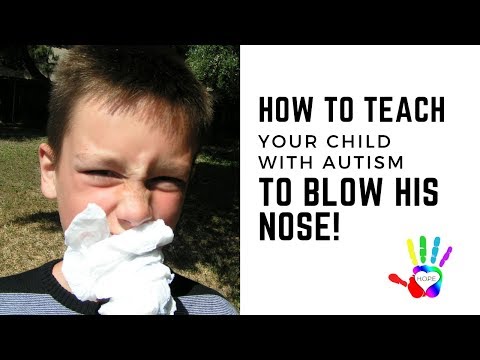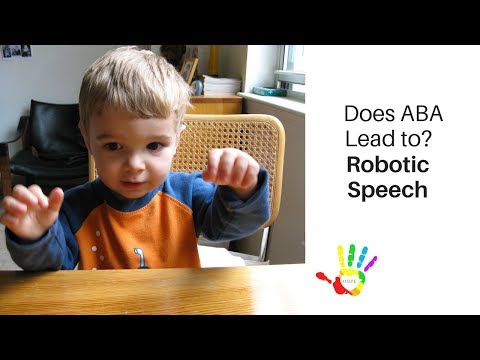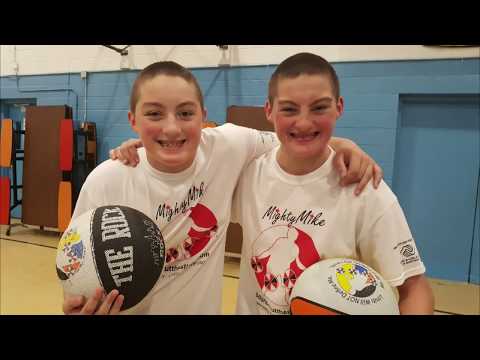Teaching a child to blow their nose can be really frustrating especially when they have Autism. Children with Autism often have sensory needs that make it more aversive for them to allow an adult to touch their nose to teach them to blow it.
Great news! With these strategies, you don’t have to! These simple techniques can make it a lot more fun kids, teachers and parents!
Enjoying these videos? Check out my blog where I go into even more depth on topics just like this one. https://hopeeducationservices.com
Struggling with potty training your child with Autism. Download a free resource guide at Http://www.autismpottytraining.com
Is your child struggling with trying new foods? Download a Free step by step approach to encouraging the most picky eaters to try new things! Http://www.justfreakingeatit.com
Is your child with Autism starting school or are you struggling with developing a meaningful connection with your child’s teachers? Download my free e-Book Http://www.schoolwithautism.com
Are you waiting for ABA services for your child to start or would you like to learn how you can help your child get the most out of ABA therapy. Check out my book on Amazon designed to help parents just like you.
https://www.amazon.com/Parents-Introd…
Let’s connect on social media:
Facebook: Http://www.facebook.com/hopeeducationservices
Instagram: Http://www.instagram.com/hopeeducationservices
Disclaimer:
This video is intended for information purposes only. It is not intended to diagnose or treat any medical condition. The text, graphics, images, flash movies, and audio segments are not intended to be a substitute for professional medical advice, diagnosis, or treatment. Always seek the advice of your physician or other qualified health provider with any questions you may have regarding a medical condition.
The information contained in this segment is generalized. It may not be applicable in every situation. Before applying specific interventions, consult a behaviorist. Any behavior intervention can result in an undesired change in behavior if not implemented correctly. No client relationship is established as a result of watching these videos. Jessica Leichtweisz and Hope Education cannot be held responsible for any misuse of the information contained in these videos. <br> <h3>Auto Generated Captions</h3>
hey there and welcome back to my channel
yesterday someone sent in an amazing
question asking for strategies on how to
help a child with autism and blow their
nose that can be something really really
challenging to teach so let’s dive right
into it so I like to help kids learn to
blow their nose the same way I like to
teach them just to blow out of their
mouth now there’s a few ways I can do
that so one is using this continent and
having them blew it around tissue and
bubbles kids tend to really like bubbles
now I have a disclaimer these are
dollars or bubbles they don’t work
really well so I wouldn’t use these
bubbles but let’s jump right into the
modeling some techniques that I like to
use so here we go when we want kids to
learn to below from their nose we want
it to be really fun so one of the things
that we have to remember is that people
with autism often have sensory issues
and they may not like their face being
touch children with autism are also far
more likely to experience
hypersensitivity so in the past someone
wiping their nose could be aversive to
them and they might have impaired that
is something that’s a really unpleasant
experience so we want to make it really
fun now I actually like to use cupcakes
on teaching kids to blow out of their
mouths with the nose that’s not a good
idea but kids also really really love
bubbles so what you can do is teach them
to blow bubbles from their nose is
actually really fun so you put your hand
underneath their nose and there we go
you got some bubbles so that actually
it’s marking off it will work the first
time if you have them better bubbles but
like I said so that’s a really fun
technique I used to like to teach kids
to blow their nose another thing that is
really simple and usually what I do is
I’m using some what kind of like a
shaping procedure if you’re an aviator
if is watching this you’re going to tell
me
it’s not exactly shaping you’re right
but what we’re gonna do right we start
off with bubbles then I’m gonna put the
cotton bow on I’m just gonna hold it up
and have them blow it off of my hand
with their nose again you just want to
hold it above their mouth that way it’s
kind of hard to demonstrate on my own
body but when you’re working with the
kid keep it above their mouth so they’re
not exploding from their mouth and
simply you can have them blow it right
out of their hands now like I said the
third thing I usually do is then go to
tissue paper toilet paper I have told
the paper because they don’t have
tissues but actually tissues work better
because they’re lighter and you’re going
to have the kids and then you’re gonna
again put it to their nose and you’re
gonna have them blow it off or make it
and move and then eventually you’re
going to get to the point where you’re
putting it to their nose or letting them
put it to their nose being very
sensitive to whether that child that
you’re teaching does have some sensory
needs and making sure that you’re not
hurting them now it’s normal for kids to
cry especially when kids are learning to
blow their nose most of the time they’re
under the age of five a lot of kids
don’t like their nose being waved
whether they’re typically developing or
whether they have autism but be very
sensitive to the child’s sensory needs
and really use as much care as you need
to in order to teach this so I really
hope this video is helpful these are the
strategies that I use if you have things
that you do I would love to hear about
them and if you’re doing this at home
then this is a really fun and easy way
you know the reason I’d like to use
these three things is it’s very visual
if you tell the child just to blow they
may not really understand what they’re
doing now there is right the fact that
when you’re blowing on your nose it is
kind of hard you know obviously you want
to be careful like if you’re sick always
have hand sanitizer when you’re teaching
this but you can also have the child if
they’re comfortable with it and your
comfort with it and the parents
comfortable put their hand by your nose
and just show them what that feels like
it’s making sure to use hand sanitizer
afterwards but this this does you know
it works for kids they typically find
this fun right away and nose blowing can
be an immersive experience these these
tips and tricks it tends to make it a
really positive experience so I hope you
liked this video
I love making these videos I wake up
every morning and it’s the first thing I
think about is what video am I going to
make for the day so if you have any
questions I would love to hear from you
because I’d love to make a video just
for you just like I made this video for
one of the viewers of the channel so
it’s just go to hope education services
comm that’s and I website drop your
email and you’ll get it automatically
some of my best e books and then just
reply to that email with your question
and be happy to answer it for you take
care and I’ll see you tomorrow
[Music]
How to teach a child with Autism to blow his nose! RvEg2AH1yFY
hey there and welcome back to my channel
yesterday someone sent in an amazing
question asking for strategies on how to
help a child with autism and blow their
nose that can be something really really
challenging to teach so let’s dive right
into it so I like to help kids learn to
blow their nose the same way I like to
teach them just to blow out of their
mouth now there’s a few ways I can do
that so one is using this continent and
having them blew it around tissue and
bubbles kids tend to really like bubbles
now I have a disclaimer these are
dollars or bubbles they don’t work
really well so I wouldn’t use these
bubbles but let’s jump right into the
modeling some techniques that I like to
use so here we go when we want kids to
learn to below from their nose we want
it to be really fun so one of the things
that we have to remember is that people
with autism often have sensory issues
and they may not like their face being
touch children with autism are also far
more likely to experience
hypersensitivity so in the past someone
wiping their nose could be aversive to
them and they might have impaired that
is something that’s a really unpleasant
experience so we want to make it really
fun now I actually like to use cupcakes
on teaching kids to blow out of their
mouths with the nose that’s not a good
idea but kids also really really love
bubbles so what you can do is teach them
to blow bubbles from their nose is
actually really fun so you put your hand
underneath their nose and there we go
you got some bubbles so that actually
it’s marking off it will work the first
time if you have them better bubbles but
like I said so that’s a really fun
technique I used to like to teach kids
to blow their nose another thing that is
really simple and usually what I do is
I’m using some what kind of like a
shaping procedure if you’re an aviator
if is watching this you’re going to tell
me
it’s not exactly shaping you’re right
but what we’re gonna do right we start
off with bubbles then I’m gonna put the
cotton bow on I’m just gonna hold it up
and have them blow it off of my hand
with their nose again you just want to
hold it above their mouth that way it’s
kind of hard to demonstrate on my own
body but when you’re working with the
kid keep it above their mouth so they’re
not exploding from their mouth and
simply you can have them blow it right
out of their hands now like I said the
third thing I usually do is then go to
tissue paper toilet paper I have told
the paper because they don’t have
tissues but actually tissues work better
because they’re lighter and you’re going
to have the kids and then you’re gonna
again put it to their nose and you’re
gonna have them blow it off or make it
and move and then eventually you’re
going to get to the point where you’re
putting it to their nose or letting them
put it to their nose being very
sensitive to whether that child that
you’re teaching does have some sensory
needs and making sure that you’re not
hurting them now it’s normal for kids to
cry especially when kids are learning to
blow their nose most of the time they’re
under the age of five a lot of kids
don’t like their nose being waved
whether they’re typically developing or
whether they have autism but be very
sensitive to the child’s sensory needs
and really use as much care as you need
to in order to teach this so I really
hope this video is helpful these are the
strategies that I use if you have things
that you do I would love to hear about
them and if you’re doing this at home
then this is a really fun and easy way
you know the reason I’d like to use
these three things is it’s very visual
if you tell the child just to blow they
may not really understand what they’re
doing now there is right the fact that
when you’re blowing on your nose it is
kind of hard you know obviously you want
to be careful like if you’re sick always
have hand sanitizer when you’re teaching
this but you can also have the child if
they’re comfortable with it and your
comfort with it and the parents
comfortable put their hand by your nose
and just show them what that feels like
it’s making sure to use hand sanitizer
afterwards but this this does you know
it works for kids they typically find
this fun right away and nose blowing can
be an immersive experience these these
tips and tricks it tends to make it a
really positive experience so I hope you
liked this video
I love making these videos I wake up
every morning and it’s the first thing I
think about is what video am I going to
make for the day so if you have any
questions I would love to hear from you
because I’d love to make a video just
for you just like I made this video for
one of the viewers of the channel so
it’s just go to hope education services
comm that’s and I website drop your
email and you’ll get it automatically
some of my best e books and then just
reply to that email with your question
and be happy to answer it for you take
care and I’ll see you tomorrow
[Music]
https://i.ytimg.com/vi/RvEg2AH1yFY/hqdefault.jpg Autism,ABA,aba therapy,education,special education,jessica leichtweisz,hope education services,autistic,applied behavior analysis,applied behaviour analysis,behvaior therapy,teaching a child to blow their nose,aspergers,autism spectrum disorder,asd Teaching a child to blow their nose can be really frustrating especially when they have Autism. Children with Autism often have sensory needs that make it more aversive for them to allow an adult to touch their nose to teach them to blow it.
Great news! With these strategies, you don’t have to! These simple techniques can make it a lot more fun kids, teachers and parents!
Enjoying these videos? Check out my blog where I go into even more depth on topics just like this one. https://hopeeducationservices.com
Struggling with potty training your child with Autism. Download a free resource guide at Http://www.autismpottytraining.com
Is your child struggling with trying new foods? Download a Free step by step approach to encouraging the most picky eaters to try new things! Http://www.justfreakingeatit.com
Is your child with Autism starting school or are you struggling with developing a meaningful connection with your child’s teachers? Download my free e-Book Http://www.schoolwithautism.com
Are you waiting for ABA services for your child to start or would you like to learn how you can help your child get the most out of ABA therapy. Check out my book on Amazon designed to help parents just like you.
https://www.amazon.com/Parents-Introd…
Let’s connect on social media:
Facebook: Http://www.facebook.com/hopeeducationservices
Instagram: Http://www.instagram.com/hopeeducationservices
Disclaimer:
This video is intended for information purposes only. It is not intended to diagnose or treat any medical condition. The text, graphics, images, flash movies, and audio segments are not intended to be a substitute for professional medical advice, diagnosis, or treatment. Always seek the advice of your physician or other qualified health provider with any questions you may have regarding a medical condition.
The information contained in this segment is generalized. It may not be applicable in every situation. Before applying specific interventions, consult a behaviorist. Any behavior intervention can result in an undesired change in behavior if not implemented correctly. No client relationship is established as a result of watching these videos. Jessica Leichtweisz and Hope Education cannot be held responsible for any misuse of the information contained in these videos.



